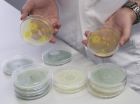(Press-News.org) Food scientists are working to block, mask and/or distract from bitter tastes in foods to make them more palatable to consumers, many of whom are genetically sensitive to bitter tastes, according to a new presentation at the 2014 Institute of Food Technologists (IFT) Annual Meeting & Food Expo® in New Orleans.
"Many factors go into why we eat what we do," said John Hayes, PhD, assistant professor of food science and director of the Sensory Evaluation Center at Pennsylvania State University, with taste consistently ranking as number one. There's also "a huge variability in how much bitterness people taste. If something is bitter you like it less and you eat it less."
Many foods, such as broccoli, spinach, asparagus, kale, Brussels sprouts, grapefruit, tea, soy and caffeine, have a bitter taste. People with a high sensitivity to bitterness eat 25 percent fewer vegetables, said Hayes.
The bitter perception is "highly complex," according to Hayes, with 25 known bitter receptor genes. "It's also not destiny. Learning can override innate aversions. You can learn to like things."
And yet as consumer preference grows for products with specific nutrients or ingredients, food scientists are working to mask or diminish bitter and other tastes, said Robert Sobel, PhD, vice president of research and innovation at FONA International.
"There's an increasing market opportunity to attenuate bitterness perception and improve palatability and preference among consumers," said Sobel.
In high-energy drinks, for example, consumers are seeking a high level of caffeine, and yet caffeine can be very bitter. Food manufacturers often add a "high-intensity" sweetener to energy drinks, and because the brain has a preference for sweetness, it diminishes the perception of bitterness. The addition of "phantom aromas," such as vanilla, berry, citrus, bacon or even cheese, can distract the brain from acknowledging a bitter to taste.
Other additives can mask or "mitigate a bitter taste." Lactisole, for example, made from carboxylic acid salt derived from Columbian coffee, can negate sweet taste. An allosteric modulator can change a food or ingredient's protein structure reducing the salty, sweet or bitter signal to the brain.
When deciding which food additives to use to diminish bitter taste, "formulators must consider differences in regional diets for effective solutions," said Sobel.
INFORMATION:
About IFT
This year marks the 75th anniversary of the Institute of Food Technologists. Since its founding in 1939, IFT has been committed to advancing the science of food, both today and tomorrow. Our non-profit scientific society—more than 18,000 members from more than 100 countries—brings together food scientists, technologists and related professionals from academia, government and industry. For more information, please visit ift.org.
Food scientists working to diminish, mask bitter tastes in foods
2014-06-24
ELSE PRESS RELEASES FROM THIS DATE:
Not everyone wants cheering up, new study suggests
2014-06-24
You may want to rethink cheering up your friends who have low self-esteem because chances are they don't want to hear it.
People with low self-esteem have overly negative views of themselves, and often interpret critical feedback, romantic rejections, or unsuccessful job applications as evidence of their general unworthiness. A new study from researchers at the University of Waterloo and Wilfrid Laurier University found that they likely don't want you to try to boost their spirits.
"People with low self-esteem want their loved ones to see them as they see themselves. ...
Metal particles in solids aren't as fixed as they seem, new memristor study shows
2014-06-24
ANN ARBOR—In work that unmasks some of the magic behind memristors and "resistive random access memory," or RRAM—cutting-edge computer components that combine logic and memory functions—researchers have shown that the metal particles in memristors don't stay put as previously thought.
The findings have broad implications for the semiconductor industry and beyond. They show, for the first time, exactly how some memristors remember.
"Most people have thought you can't move metal particles in a solid material," said Wei Lu, associate professor of electrical and computer ...
Researchers at Intermountain Medical Center develop new smartphone technology and app to diagnose and monitor adrenal gland diseases
2014-06-24
Diseases of the adrenal gland have long been difficult to diagnose. But now, researchers have found an affordable and easy way to diagnose and monitor endocrine diseases of the adrenal gland by using saliva and a smartphone.
Researchers at Intermountain Medical Center in Murray, Utah, have developed new smartphone technology to help screen patients for a number of adrenal gland diseases, including Cushing's syndrome. The new tool also helps to identify adrenal insufficiency, monitor cortisol replacement and assess physiologic changes in adrenal function.
Adrenal diseases ...
To advance care for patients with brain metastases: Reject five myths
2014-06-24
New York, NY – A blue-ribbon team of national experts on brain cancer says that professional pessimism and out-of-date "myths," rather than current science, are guiding -- and compromising -- the care of patients with cancers that spread to the brain.
In a special article published in the July issue of Neurosurgery, the team, led by an NYU Langone Medical Center neurosurgeon, argues that many past, key clinical trials were designed with out-of-date assumptions and the tendency of some physicians to "lump together" brain metastases of diverse kinds of cancer, often results ...
Mayo Clinic researchers say gene in brain linked to kidney cancer
2014-06-24
JACKSONVILLE, Fla. — A gene known to control brain growth and development is heavily involved in promoting clear cell renal cell carcinoma, the most common form of kidney cancer, researchers from Mayo Clinic in Florida are reporting.
Their study, published in Cancer Research, reveals that the gene NPTX2, plays an essential role in this cancer type, which is resistant to common chemotherapy and has a five-year overall survival rate of less than 10 percent in patients with metastatic disease.
MULTIMEDIA ALERT: Video and audio are available for download on the Mayo Clinic ...
Virus kills triple negative breast cancer cells, tumor cells in mice
2014-06-24
A virus not known to cause disease kills triple-negative breast cancer cells and killed tumors grown from these cells in mice, according to Penn State College of Medicine researchers. Understanding how the virus kills cancer may lead to new treatments for breast cancer.
Adeno-associated virus type 2 (AAV2) infects humans but is not known to cause sickness. In prior studies, the researchers tested the virus on a variety of breast cancers that represent degrees of aggressiveness and on human papillomavirus-positive cervical cancer cells. The virus initiated apoptosis -- ...
Morphable surfaces could cut air resistance
2014-06-24
CAMBRIDGE, Mass-- There is a story about how the modern golf ball, with its dimpled surface, came to be: In the mid-1800s, it is said, new golf balls were smooth, but became dimpled over time as impacts left permanent dents. Smooth new balls were typically used for tournament play, but in one match, a player ran short, had to use an old, dented one, and realized that he could drive this dimpled ball much further than a smooth one.
Whether that story is true or not, testing over the years has proved that a golf ball's irregular surface really does dramatically increase ...
CNIO researcher Ana Losada revises the role of cohesin in cancer
2014-06-24
Massive sequencing of cancer genomes brings to light new genes every day that could be involved in the process of tumour formation. A good example of this is cohesin, a ring-shaped protein complex that embraces DNA to control cell division. Just a few months ago, and after several studies in the same direction, the sequencing of thousands of tumour samples identified the STAG2 gene—whose product forms part of cohesin—as one of the most frequently mutated genes in several types of cancer such as bladder cancer and melanoma.
The challenge now is to understand the link between ...
Quick, easy, inexpensive cortisol testing should soon be available on all smartphones
2014-06-24
CHICAGO, IL—Researchers have developed a device that uses any smartphone to measure the cortisol concentration in saliva. The device was presented Tuesday, June 24, at ICE/ENDO 2014, the joint meeting of the International Society of Endocrinology and the Endocrine Society in Chicago.
"We have developed a method for measuring cortisol in saliva using a smartphone and a disposable test strip. This innovation enables anyone with a smartphone to measure their salivary cortisol level quickly, accurately, and affordably," said lead study author Joel R. L. Ehrenkranz, MD, director ...
Sweet sweet straw
2014-06-24
This news release is available in German. Erythritol has many great advantages: it does not make you fat, it does not cause tooth decay, it has no effect on the blood sugar and, unlike other sweeteners, it does not have a laxative effect. In Asia it is already widely used and it is becoming more and more common in other parts of the world too. Up until now, erythritol could only be produced with the help of special kinds of yeast in highly concentrated molasses. At the TU Vienna, a method has now been developed to produce the sweetener from ordinary straw with the help ...

